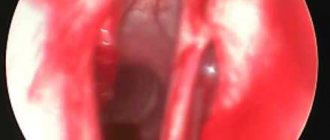Lameness is a common disorder in veterinary practice of the lower extremities of dogs. The pet's gait changes, becomes asymmetrical, and when moving it experiences serious discomfort. Most often, the disorder appears due to injuries to the extremities, but if their signs are absent, the cause may lie in pathologies of the musculoskeletal system and internal organs. What should the owner do when the dog is limping on its front leg and there are no noticeable injuries?
The dog is limping on its front leg, there are no visible injuries
Symptoms of pathology
Lameness in dogs is a change in gait, which is accompanied by a shortening of the step, partial or complete exclusion of the limbs from the walking process, when the animal only leans lightly on it, or even tucks in when moving. It is not an independent disease, but a symptom of pathologies that are associated with pain, discomfort or muscle weakness in the limbs.
The disorder can manifest itself spontaneously, after prolonged physical exertion or a state of rest, and is sometimes accompanied by additional symptoms - swelling, muscle atrophy, general malaise (loss of appetite, lethargy, apathy, etc.). Features of lameness and accompanying manifestations play an important role in making a diagnosis, so they need to be given special attention.
Lameness is not an independent disease, but a symptom of pathologies
Causes of lameness in the hind legs
A dog may fall on its hind legs with a nervous form of plague. Weakness of the hind limbs may also occur with infectious enteritis and hepatitis.
If a dog's hind leg suddenly gives way, accompanied by severe pain, this may indicate protrusion of the intervertebral discs in the lumbar and thoracic region.
Since the clinical signs of all the diseases presented are very similar to each other, the correct diagnosis is made only after an X-ray examination. Based on its results, the doctor decides what to do next and prescribes appropriate treatment.
Main types of lameness
Before looking for the cause of changes in a dog’s gait, you need to carefully observe your pet - there are several types of lameness, each of which has its own characteristics of gait disturbance.
| Type of lameness | Image | Peculiarities |
| Leaning limb | It appears when the dog rests its affected limb on the ground while walking. She tries to minimize the duration of contact of the paw with the surface, lightly touching it with a pad, and at rest she can tuck her limb. This type of disorder is typical for damage to soft and hard tissues, hereditary pathologies (elbow dysplasia), arthritis, arthrosis | |
| Suspended limb | The disorder can be noticed at the moment when the animal moves the limb forward when walking. Due to discomfort, the animal is not able to take a step of normal length, and puts the diseased paw next to the healthy one, as a result of which the step shortens. With intense pain, there may be no lifting of the limb at all, and when moving, the dog begins to drag it along with him. This type of disorder is observed when muscle structures, lymph nodes and nerve tissues are affected. | |
| Mixed lameness | It appears both when moving a limb and when it rests on the ground. A mixed type of disorder is possible when the pathological process is localized in muscle and nerve endings | |
| Neurological paresis | The peculiarity of this type of disorder is the absence of pain, and changes in gait are associated with muscle weakness |
In addition, lameness in a dog can be intermittent (temporary) or permanent. In the first case, the disorder is an unsystematic gait disturbance that appears spontaneously and resolves on its own. A permanent type of disorder is observed for a long time with any movements, and sometimes at rest - the dog tries to spare the sore paw, squeezing it or holding it in an unnatural, tense position.
Attention! The pain threshold in dogs is quite high, and if the animal does not lean on a limb or presses it, then we are talking about intense pain and serious tissue damage, as well as diseases of the musculoskeletal system.
Causes of lameness
The exact causes of lameness in a dog can only be determined by a veterinary medicine specialist after collecting anamnestic data and checking the condition of the animal’s musculoskeletal system. In many cases, additional laboratory blood tests may be necessary to identify metabolic disorders or the presence of infectious factors causing lameness.
The most common causes of this symptom are:
- Fractures. After a fall or a strong blow, the dog stops stepping on the injured hind or front paw. The limb becomes swollen, hot and painful. The animal is restless, whines, and may also show aggression when attempting to be examined.
- Crick. Lameness in a dog appears after prolonged or intense physical activity, sudden jumps and turns. The limb becomes swollen, pain manifests itself on palpation, passive flexion and extension of the joints. This is often observed in puppies after unsuccessful jumps from high objects.
- Muscle rupture. In addition to dysfunction of the limb, palpation can detect a tissue defect in the lesion.
- Myositis. After prolonged physical activity, large amounts of lactic acid accumulate in muscle tissue, causing severe pain. A characteristic sign in this case is that intense lameness appears after a state of rest, and gradually decreases when walking. After a few days, the irritating substance dissolves, the pain goes away, and the functions of the limbs are restored. However, there is rheumatoid myositis, which is caused by prolonged or frequent hypothermia. In this case, treatment is necessary, and the prognosis is cautious.
- Nail injury. The dog does not step on the paw, shows great anxiety, and yelps when accidentally touching the damaged area. A torn nail bleeds.
- Cuts. The animal suddenly stops stepping on its paw, clenches it and whines. In this case, heavy bleeding is observed due to the presence of a large number of blood vessels in this area. A deep cut can cause ligament or tendon injury. In this case, the prognosis will be unfavorable, and lameness will remain forever. If the dog is lame, but there is no bleeding, then the paw pads should be checked for the presence of sharp foreign objects, punctures and small scratches.
- Plague of carnivores. In the nervous form of this disease, the dog’s hind legs sharply give way, and the animal can fall heavily to one side.
- Lesions of the central nervous system. It is difficult for the pet to coordinate the movements of its limbs and to stand up. Lameness can be observed constantly or be periodic.
- Ligament rupture. Severe lameness is observed due to the dog's inability to bear weight on the injured limb. In this case, the prognosis is unfavorable, since these tissues are not restored, and the paw always remains slightly bent.
Possible causes of lameness in dogs
There can be many reasons for pathological changes in gait in dogs, but in the absence of visible damage, it is quite difficult to determine them, so the owner of the animal should contact a veterinarian. All the reasons why a dog may have a gait disorder are divided into mechanical, that is, those that were caused by external factors, and medical, which includes disorders of the musculoskeletal system.
For an accurate diagnosis, consult your veterinarian
Mechanical reasons
Most often, lameness, which arose under the influence of traumatic factors, is accompanied by external damage - wounds, swelling, abrasions, etc., but sometimes gait disturbance is the only symptom.
- Splinter . Small splinters may be invisible to a prying eye, but cause serious discomfort to the pet, which is why it begins to limp. The danger is that the foreign body often causes suppuration and abscesses, which require surgical treatment.
- Insect bites . Stings from bees, wasps, poisonous spiders and other insects are another common cause of lameness in animals. Tick bites are especially dangerous - the attached parasite not only causes discomfort when walking, but can also cause dangerous diseases, including encephalitis.
- Dislocations, sprains, fractures . If the lameness was preceded by heavy physical activity, falls or blows, the cause of the disorder may be muscle strains, joint dislocations or bone damage. Most often, representatives of large breeds with short legs and small individuals that have thin, fragile bones are susceptible to such damage.
How to remove a splinter from a dog's paw
Attention! The most alarming symptom is a gradually increasing lameness - it is observed in cancer and degenerative processes of the musculoskeletal system (arthritis, arthrosis).
Medical reasons
Medical causes of lameness include various diseases that are associated with dysfunction of the musculoskeletal system or other organs:
- inflammatory processes in muscle and nerve tissues;
- diseases of the central nervous system and peripheral nervous system;
- degenerative pathologies of the musculoskeletal system (arthritis, arthrosis, osteoarthritis);
- thrombosis of large vessels;
- pathologies of the spine, accompanied by compression of the nerve roots (hernia, protrusion);
- benign and malignant neoplasms;
- pathologies of internal organs, which are accompanied by pain radiating to the limbs;
- errors in nutrition, lack of vitamins and nutrients;
- overweight, too rapid weight gain in young individuals.
The causes of lameness in dogs can be various diseases.
Unobvious, but the most serious causes of lameness include genetic diseases of the musculoskeletal system, to which some breeds of dogs are susceptible - hip or knee dysplasia, muscle ataxia. These are pathologies that cannot be treated, and the only thing doctors can do is to stop the symptoms and alleviate the pet’s condition.
The dog is limping
There are situations when dogs begin to limp for no apparent reason and one wants to understand what is happening and how to help the pet cope with the problem that has arisen.
Here it is worth remembering that without proper education, as well as practical experience in treating pets and without special equipment for diagnostics and laboratories for research, there is no way to tell what’s wrong with the dog and why it behaves this way. Contacting a veterinarian will be the right solution to this issue.
The dog is limping and leaning in, does not stand on its hind leg, leg, what should I do, is it bad or does not eat, whines, trembles, shakes, falls over on its side
There can be several reasons for a dog's lameness: injuries (injuries, sprains, wounds), burns or frostbite, infections.
If you notice that your dog is limping, you should immediately consult a veterinarian. If a wound is noticed on the paw, it is treated with saline solution and shown to a specialist.
Prayers
If the dog is trembling, limping on its hind legs and cannot stand up, then it may be myositis (inflammation of the muscles).
In this case, a paw massage and heat are needed, but only a veterinarian can make the correct diagnosis.
It is possible that the dog has infectious arthritis, which is accompanied by swelling of the joints and refusal to eat. It is necessary to urgently take your pet to the doctor.
A dog limps on its front leg after sleeping, after lying down, an injection in the leg, vaccinations, a walk, a tick bite, what to do?
If a dog limps after sleeping and then goes away, it could be a dislocated shoulder. Here you need a specialist consultation and an x-ray.
The cause of lameness after an injection is an incorrectly performed procedure or painful sensations. These symptoms will pass and the dog will begin to walk without lameness.
If the dog begins to limp after a walk, then you need to check the pads of the paws, there may be a foreign object stuck there or a broken claw. In this case, try to remove the object yourself and disinfect the wound. A broken claw is removed at a veterinary clinic.
Tick bites are dangerous due to infectious diseases, which result in increased body temperature, swollen joints, and lameness. The pet needs to be treated urgently by a doctor.
The dog limps on one leg and then on the other without any visible reason or damage, without pain, no wound, no reason
If lameness appears periodically, but there are no injuries on the paws, then it may be osteochondrosis. Lameness without pain occurs with neurological paresis. A veterinarian can treat such diseases, but you cannot help your pet on your own.
The dog limps when it gets up and then walks, runs, from time to time, from old age, only at home
If it is difficult for your pet to lie down and get up, and mobility is restored during movement, then this may be a symptom of arthritis. In this situation, you cannot do without the help of a veterinarian.
Aging dogs are susceptible to musculoskeletal diseases and arthritis, which is why lameness occurs. You need to show your pet to a doctor and surround it with attention and care.
comments 3
- 3 Comments
- 0 Trackbacks & Pingbacks
- Anya:
06/09/2017 at 14:46I was walking the dog and suddenly I saw how my dog began to bite its paw and limp. I sat her down on the ground and began to look at the place where the pain was, I understood this from her face, and while I was looking, I noticed how bees were flying near us and we ran home. At home, I put the dog down and put a so-called “bucket” on his face and started Googling how to help the poor guy. I just found something that needed to be treated with a soda solution, I treated it, but now this paw (on which there is a small hole) is shaking. What to do? how to treat?
- oxy:
08/01/2017 at 20:12
alas, but a lame dog is no longer uncommon(
- Olga:
10.29.2017 at 12:14
please help, the mongrel puppy, for no reason at all, began to limp on his front paw, or rather does not step on it at all, whines very loudly, does not really eat, and his nose is wet and cold. There were no blows, no open or stabbing wounds, I examined everything, and when I start to feel above my knees, she starts whining and biting me, somewhere under the armpit just below. It is problematic to contact a veterinarian; there is only a pharmacy. I can no longer watch him ask for help with his eyes, maybe tell me the names of the presumptive diagnosis and medications. I pray!!!!!!!! Thank you in advance
Add a comment Cancel reply
What an owner should do if a dog has lameness
As a rule, lameness in a dog can be detected with the naked eye, but in some cases it appears slightly, or only during certain periods. If the owner suspects a gait disorder in the pet, the following test can be performed - walk the dog along wet sand or wet soil, and then measure the distance between the footprints remaining on the surface. In healthy individuals, the step length is the same, and if one step is shorter than the other, we may be talking about problems with the musculoskeletal system.
If the animal begins to limp, you need to carefully examine and feel the limb for external or internal damage, trying not to cause pain to the animal. It is strictly not recommended to straighten limbs, straighten dislocations or carry out other manipulations on your own - this can lead to serious consequences for the pet’s health. You should also not use any medications without a doctor’s prescription - the only justified therapeutic agent in this case is vitamin B (the dose must be selected depending on the weight of the animal).
Inspect the limb for damage
Regardless of the presence or absence of visible injuries, the dog should be taken to a veterinarian for diagnosis - the doctor will conduct an external examination and functional tests, and, if necessary, send the animal for x-rays, blood tests, ultrasound and other studies.
Important! Even if a dog’s lameness goes away on its own over a certain period of time, it is better to show it to a veterinarian - changes may have occurred in the joints, bones and other structures that will cause serious complications in the future.
Treatment of lameness in dogs
You can begin to treat the animal only after making an accurate diagnosis.
Therapy for lameness in a dog depends on the disease that caused this symptom and is aimed at eliminating discomfort and the underlying pathology, as well as restoring normal functioning of the musculoskeletal system. As symptomatic treatment, painkillers, decongestants and non-steroidal anti-inflammatory drugs are used, and during the recovery period, chondroprotectors and B vitamins. For uncomplicated pathologies, conservative therapy can usually be used, and in severe cases, surgical intervention is required - suturing wounds, removing tumors, arthroplasty, administering medications drugs into joints, etc.
Video - Bone fractures in animals
Prevention of lameness in dogs
To prevent lameness, owners must closely monitor the health of their pets, pay attention to a balanced diet and proper distribution of physical activity. The dog needs special control while walking - you need to exclude fights with other animals, falls from heights and other factors that can lead to injuries, and upon arriving home, carefully examine the animal’s limbs for damage. Representatives of breeds that are prone to genetic diseases, as well as older individuals, require regular preventive examinations by a veterinarian.
Lameness in a dog is an alarming symptom that cannot be ignored or tried to be eliminated on your own. Any delay or inept action can lead to serious consequences for the pet’s health, so it should be taken to a veterinary clinic immediately.










